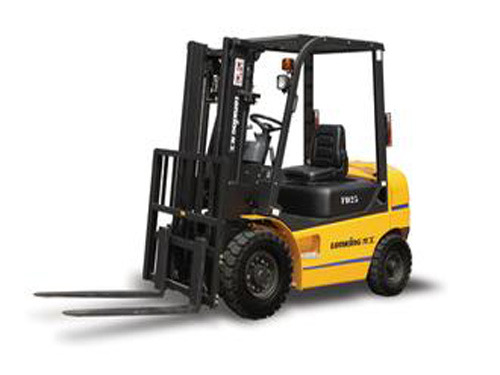
The data of the forklift's structural features and working performance are referred to as the forklift's technical parameters, and the forklift's technical parameters are divided into performance, size, and weight parameters.
Forklift main performance parameters are: rated lifting weight, load center distance, maximum lifting height, free rise height, gantry inclination, maximum lifting speed, maximum driving speed, maximum climbing, minimum transition radius, engine (motor, battery ) Performance indicators.
The main dimensions include: dimensions (length, width, height), wheelbase, front and rear wheelbase, and minimum ground clearance.
The main weight parameters are: self-weight, front axle load with no load, axle load with no load, axle load with full load, axle load with full load, etc.
1. Rated weight: Specifies the maximum mass of the fork lift truck.
2. Load center distance: The distance from the center of gravity of the rated weight of the goods to the vertical surface of the fork. Expressed in "mm". China according to the different rated capacity, provides the corresponding load center distance, as a reference value.
3. The maximum lifting height when the rated lifting capacity is: under the rated lifting weight, the fork is raised to the highest position, the mast is vertical, and the vertical distance from the ground to the upper plane of the fork.
4. Free rise height: In the no-load state, the vertical mast, the height of the gantry will not rise, the maximum vertical distance from the plane of the fork to the ground.
5. Mast rake angle, gantry caster: The maximum angle of inclination of the gantry forward or backward relative to the vertical position in the no-load condition.
6. Full-load, no-load maximum lifting speed: The maximum speed at which the fork or attachment is lifted under rated capacity or under no load.
7. Full-load, no-load maximum operating speed: The maximum speed at which the vehicle travels on the entire hard surface under rated capacity or no load.
8. Maximum climbing grade: The maximum slope that can be climbed when the vehicle is running steadily at the specified speed under no load or rated capacity.
9. Minimum transition radius: In the no-load state, the vehicle moves forward or backward at a low speed, turns left or right, and the maximum distance from the outside of the body to the turning center when the steering wheel is at the maximum rotation angle.
10. Forklift length: For counterbalanced forklifts, the horizontal distance from the tip of the fork to the end of the body.
11. Forklift width: The maximum horizontal distance between the two outsides of the forklift.
12. Forklift height: The vertical distance from the ground to the top of the forklift.
13. Wheelbase: The horizontal distance between the front and rear axle centerline.
14. Track: The distance between the left and right wheels of the same bridge and the ground contact surface. The wheel pitch of multiple wheels is measured at the center point.
15. Minimum ground clearance: The vertical distance from the lowest point to the ground, except for the wheels, when the vehicle is in the rated capacity or under no load.
16. Weight: The mass of the vehicle under no load.
17. Bridge load: The vertical load the bridge bears under no-load or rated-lift conditions.
Ningbo Yejin Supply Chain Management Co.,Ltd , https://www.car-parts-accessories.com
